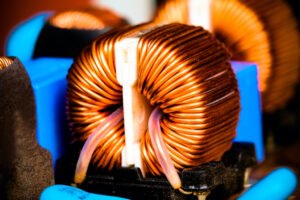Electroplating is applying a thin layer of other metals or alloys on the surface of certain metals by electrolysis. It is a process of applying a metal film to the surface of metals or other materials to prevent oxidation (such as rust), improve wear resistance, electrical conductivity, reflectivity, and corrosion resistance (copper sulfate, etc.), and enhance aesthetics. (The outer layer of many coins is also electroplated.)
When plating, the plating metal or other insoluble material is used as the anode and the workpiece to be plated is used as the cathode. The cations of the plating metal are reduced on the surface of the workpiece to be plated to form the plating layer. To exclude the interference of other cations, and to make the plating layer uniform and solid, it is necessary to use a solution containing plating metal cations as the plating solution to keep the concentration of plating metal cations constant.
The purpose of electroplating is to coat the substrate with a metallic layer that changes the surface properties or dimensions of the substrate. Electroplating can enhance the corrosion resistance of metals (plating metals are mostly corrosion-resistant metals), increase hardness, prevents abrasion, and improve electrical conductivity. Smoothness, heat resistance, and surface aesthetics are also part of the reasons.
Feiyu’s zinc alloy die-casting products are electroplated and come in different colors, such as black, silver, bright pink, gold, etc., depending on the customer’s needs.
The role of electroplating.
A technique that uses the electrolytic cell principle to deposit a metal cladding layer on mechanical products that adhere well but has properties different from those of the base material.
Electroplated layers are more uniform than hot-dipped layers and are generally thinner, ranging from a few microns to tens of microns.
By electroplating, it is possible to obtain decorative protective and functional surface layers on mechanical products and repair worn and mishandled workpieces.
In addition, different roles depending on the plating requirements. They in include.
- Copper plating: Priming enhances the ability to adhere to the plating layer and corrosion resistance. (Copper is easy to oxidize, copper green is no longer conducive after oxidation, so copper plating products must be done copper protection)
- Nickel plating: Priming or appearance improves corrosion resistance and wears resistance, (where chemical nickel for the modern process of wear resistance is better than chrome plating).
- Gold plating: Improves the conductive contact impedance, and enhances signal transmission. (Gold is the most stable, but also the most expensive.)
- Palladium-nickel plating: Improve the conductive contact impedance, improve signal transmission, and wear resistance more than gold.
- Silver plating: Improve the conductive contact impedance, and enhance signal transmission. (Silver performance is the best, easy to oxidize, and oxidation is also conductive).
Electroplating is a method of laying a layer of metal on a conductive body by using the principle of electrolysis. In addition to electrical conductors, the plating can also be used on specially treated plastics.
The process of electroplating.
The plated metal is at the anode and the substance to be plated is at the cathode.
When a cathode is connected to an electrolyte solution consisting of positive ions of plated metal, the metal at the anode is oxidized (loses electrons) and the positive ions in the solution are reduced (gains electrons) to atoms at the cathode and accumulate on the surface of the cathode.
The aesthetics of the plated object after plating is related to the current level, the lower the current, the more beautiful the plated object will be; on the contrary, it will have some uneven shape. The main uses of electroplating include the prevention of metal oxidation (e.g. rusting) and decoration.
Zinc Alloy electroplating solution formulation process.
High-temperature weak alkali etching → cleaning → pickling → cleaning → zinc dipping → cleaning → secondary zinc dipping → cleaning → pre-copper plating → cleaning → pre-silver plating → cyanide bright silver plating → recovery washing → cleaning → silver protection → cleaning → drying.
The plating material requirements.
Most of the plating layers are single metals or alloys, such as titanium-palladium, zinc, cadmium, gold or brass, bronze, etc.; there are also diffuse layers, such as nickel-silicon carbide, nickel-fluoride graphite, etc. There are also cladding layers, such as the copper-nickel-chromium layer on steel, the silver-indium layer on steel, etc.
The substrate materials for electroplating are not only iron-based cast iron, steel, and stainless steel, but also non-ferrous metals, or ABS plastics, polypropylene, polysulfone, and phenolic plastics, but the plastics must undergo special activation and sensitization treatment before plating.
The working principle of electroplating.
Plating requires a low-voltage, high-current power supply to the plating bath and an electrolytic device consisting of the plating solution, the part to be plated (cathode), and the anode.
The composition of the plating solution varies depending on the plating layer, but all contain the main salt that provides metal ions, complexing agents that can complex the metal ions in the main salt to form complexes, buffering agents that are used to stabilize the pH of the solution, anode activators and special additives (such as brightening agents, grain refiners, leveling agents, wetting agents, stress relievers and mist suppressants, etc.).
The electroplating process is a process in which metal ions in the plating solution are reduced to metal atoms by an electrode reaction under the action of an external electric field and metal deposition is carried out on the cathode.
In a plating bath with a plating solution, a cleaned and specially pretreated part to be plated is used as a cathode and an anode is made of plating metal, and the two poles are connected to the positive and negative terminals of a DC power supply respectively.
The plating solution consists of an aqueous solution containing compounds of the plating metal, conductive salts, buffers, pH adjusters, additives, etc.
When energized, the metal ions in the plating solution, move to the cathode to form a plating layer under the effect of potential difference. The metal of the anode forms metal ions in the plating solution to maintain the concentration of the metal ions being plated.
In some cases, such as chromium plating, an insoluble anode made of lead and the lead-antimony alloy are used. It only plays the role of transferring electrons and conducting current. The concentration of chromium ions in the electrolyte depends on the periodic addition of chromium compounds to the plating solution to maintain it.
When plating, the quality of the anode material, the composition of the plating solution, temperature, and current density all determine the result.
The way of electroplating.
Plating is divided into
- Hanging plating:
Hanging plating is suitable for general-size products, such as auto parts, and bicycle parts.
- Barrel plating:
Barrel plating is used for plating a high volume of smaller metal objects in one sitting.
- Continuous plating:
Continuous plating is suitable for batch production of wire.
- Brush plating:
Brush plating is suitable for partial plating or repair.
- Roll plating:
Roll plating is suitable for small parts, such as zinc alloy parts for cell phone holders.
The plating method is mainly related to the size and batch of the parts to be plated.
Plating solution has acidic, alkaline and acidic and neutral solutions with a chromium compound. No matter what kind of plating method is used, the plating tank and hanging tool which are in contact with the products to be plated and the plating solution should have a certain degree of versatility.
Classification of plating.
The composition of the plating can be divided into three categories:
- single metal plating
- alloy plating
- composite plating
By application, they can be classified as follows:
- Protective plating.
- Decorative plating.
- Decorative plating.
- Restorative plating.
- Functional plating
Feiyu’s zinc alloy products are available in both barrel and fine plating to meet the needs of different customers.
Please contact us to solve more questions about the products. 100% matching your solutions.
Quick Links:
🔗Detailed Tour of FEIYU Factory – Environment







